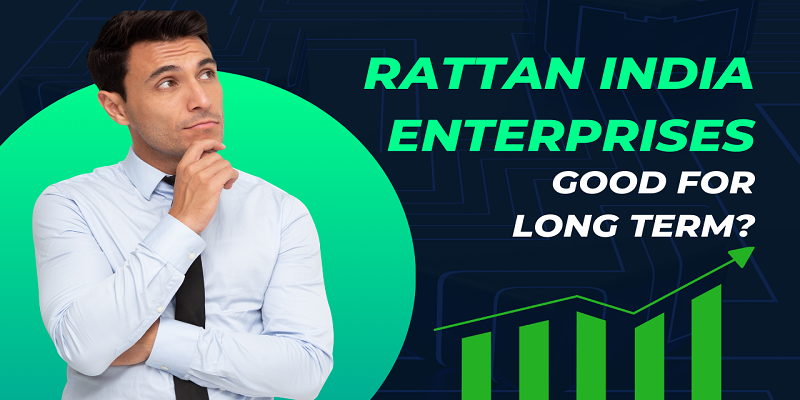Investing in stocks can be daunting, particularly when choosing an organization for long-term investments. One company that has captured investor attention recently is RattanIndia Enterprises Ltd, with roots in various sectors such as renewable energy, e-commerce and fintech – giving it a broad portfolio that might appeal to long-term investors. In this blog post we’ll investigate whether RattanIndia Enterprises Ltd is suitable for such an approach by exploring its financial health, market position, growth potential and potential risks.
Understanding RattanIndia Enterprises Ltd.
RattanIndia Enterprises Ltd. is part of the RattanIndia Group, a partnership with interests in power, renewable energy, and financial services. The company has been diversifying its portfolio to include sectors such as e-commerce and fintech, aiming to capitalize on India’s growing digital economy. This strategic diversification can be a double-edged sword, offering both opportunities and risks for investors.
Financial Health
One of the first things to look at when considering a long-term investment is the company’s financial health. RattanIndia Enterprises Ltd. has shown a mixed financial performance over the past few years. Here are some key financial metrics to consider:
- Revenue Growth: The company’s revenue growth has been inconsistent, partly due to its diversified portfolio and shifting focus on different sectors.
- Profit Margins: Profit margins have been under pressure, especially in the renewable energy sector, which has high initial costs and long payback periods.
- Debt Levels: High levels of debt can be a red flag for any company. RattanIndia has had periods of high debt, particularly due to its investments in the power sector. However, the company has been making efforts to reduce its debt load.
- Cash Flow: Positive cash flow is essential for a company’s sustainability. RattanIndia’s cash flow has been volatile, reflecting the fluctuating nature of its business operations.
Market Position and Competitive Advantage
RattanIndia Enterprises Ltd. operates in highly competitive sectors. Here’s a closer look at its market position:
- Renewable Energy: The company has a significant presence in the renewable energy sector, with several operational wind and solar power projects. The push for renewable energy globally and in India provides a growth opportunity, though the sector is crowded with many players.
- E-commerce and Fintech: The company’s foray into e-commerce and fintech is relatively new. These sectors offer high growth potential, but RattanIndia will face stiff competition from established players.
- Brand Reputation: Building a strong brand takes time, especially in new sectors. RattanIndia is known in the power sector, but it needs to establish itself in the e-commerce and fintech markets.
Growth Prospects
The long-term growth prospects of RattanIndia Enterprises Ltd. depend on several factors:
- Industry Growth: The renewable energy sector is expected to grow significantly as countries move towards sustainable energy solutions. Similarly, the e-commerce and fintech sectors are booming in India, driven by increasing internet penetration and digital payments.
- Government Policies: Supportive government policies can boost growth. In India, there are several initiatives to promote renewable energy and digital transformation, which can benefit RattanIndia.
- Innovation and Technology: Staying ahead in technology and innovation is crucial, especially in sectors like fintech. RattanIndia’s ability to innovate and adapt to new technologies will be key to its long-term success.
- Strategic Partnerships: Collaborations and partnerships can accelerate growth. RattanIndia has entered into various partnerships in the renewable energy and fintech sectors, which could enhance its market position and capabilities.
Potential Risks
Investing in RattanIndia Enterprises Ltd. comes with its share of risks:
- Market Volatility: The stock market can be highly volatile, and sector-specific risks can impact RattanIndia’s performance. For example, changes in energy prices or regulatory changes can affect its renewable energy business.
- High Competition: Both the renewable energy and fintech sectors are highly competitive. RattanIndia needs to constantly innovate and offer superior services to stay ahead.
- Debt Burden: While the company is working on reducing its debt, a high debt burden can limit its ability to invest in new projects and can affect profitability.
- Execution Risk: Diversifying into new sectors requires efficient execution. Any missteps in strategy or execution can negatively impact the company’s growth prospects.
Conclusion
Is RattanIndia Enterprises Ltd. good for the long term? The answer depends on various factors, including the company’s ability to navigate challenges and leverage opportunities. Here are some takeaways:
- Diverse Portfolio: The company’s diverse portfolio can be a strength, offering exposure to high-growth sectors. However, managing such a diverse portfolio requires effective execution and strategic focus.
- Growth Potential: There is significant growth potential in the renewable energy, e-commerce, and fintech sectors. RattanIndia’s presence in these sectors positions it well for long-term growth.
- Financial Health: While the company has shown efforts to reduce debt and improve financial stability, consistent revenue growth and profitability remain critical.
- Risk Management: Potential investors need to consider the risks, including market volatility, competition, and execution challenges.
RattanIndia Enterprises Ltd can be an attractive option for long-term investors if the company continues to innovate, implement strategies effectively, and take advantage of growth opportunities across key sectors. To make an informed investment decision it’s essential to conduct extensive research on RattanIndia Enterprises Ltd and keep abreast of industry developments as well as company updates.
RattanIndia Enterprises Ltd offers promising long-term investment returns, but like any investment requires careful evaluation and monitoring. Diversified exposure to emerging sectors coupled with strategic execution makes this asset class worth adding to a long-term portfolio.



